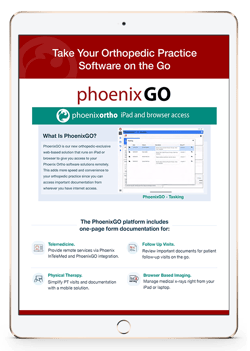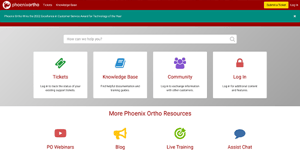Telemedicine took the healthcare services world by storm in 2020. While many healthcare facilities had been working on implementing remote visit solutions prior to 2020, the COVID-19 pandemic forced the issue and left many orthopedic clinics scrambling to add this new technology to their clinical workflows.
The benefits of being able to communicate with patients remotely and share descriptions and pictures of their health issues has revolutionized the way care is delivered. However, it is all too common for orthopedic clinics, whose physicians often rely on in-person examinations and x-ray images to accurately diagnose and treat musculoskeletal conditions, to struggle with implementing telehealth solutions in their daily operations workflows.
How Is Telemedicine Used in Orthopedic Clinical Practice?
There are many uses for telemedicine and telehealth solutions in an orthopedic workflow. For example, a telemedicine app could be used to collect important patient information like medical health history data. A patient could share pictures of an injury or a description of their problem—where the pain is, how much it hurts, how it limits their motion, etc.
Telemedicine apps are also sometimes used by whole networks of doctors. A primary care physician might refer their patients to an orthopedist through the app for specialized orthopedic care.
Orthopedic practices may also use telemedicine solutions to send out email or text-based reminders to patients about important appointments and other asynchronous communications. Alternatively, some orthopedic physicians may use a telemedicine app to conduct a live remote visit (sometimes called a virtual visit) to consult with their patients in real time.
What Are the Limitations of Telemedicine for Orthopedics?
While telemedicine offers numerous benefits to orthopedic practices—such as saving time, increasing their reach, and improving collections. However, there are also some limitations and potential drawbacks to using telemedicine for orthopedics.
For example, the Harvard Health Medical School notes that it’s just not possible to perform every type of patient visit remotely, and that “While insurance companies are increasingly covering the cost of telehealth visits during the COVID-19 pandemic, some services may not be fully covered, leading to out-of-pocket costs.”
In orthopedics, many physicians rely on in-person examinations combined with medical x-rays to provide accurate diagnoses. This, in turn, is critical for creating effective and safe treatment plans. While a patient’s explanation of their health issue given in a written description or during a virtual visit can provide important information, an in-person visit where the orthopedist can examine the injury site in detail and take medical x-rays will be much more informative.
The issue of payer organizations (like insurance companies) not covering telehealth solutions can be a bit complicated. It’s up to each payer to determine what services they will or will not cover, what the coding criteria will be for them to pay for telehealth-based services, and what their customers’ deductibles and copays will be. So, there will be a lot of room for variance in what doctors can collect from payer organizations for their telemedicine services. However, this has always been true of any medical service.
What makes the volatility of coverage for telehealth services a major problem is that patients may not always be able to easily cover the cost of health services. This can create delays in collections processes for telemedicine-based services.
Steps to Take in Planning Your Telemedicine Workflow
So, what can you do to successfully integrate telemedicine with your workflows to maximize the benefits while minimizing the impacts of any cons of using this technology? Here are a few steps for integrating telehealth with your clinical workflow:
1: Make Sure Your Telehealth/Telemedicine System Can Fully Integrate with Your EHR and PM Solutions
Is the telehealth app you’re looking at able to integrate with your existing software workflows—particularly your Electronic Health Records (EHR), picture archiving and communication system (PACS), and practice management (PM) solutions?
Setting up an integration between your telemedicine solution and your EHR, PACS, and PM software is important for ensuring that patient data can be easily shared between the app and your in-office solutions. However, this can be made much easier by using an integrated EHR, PACS, PM, and telemedicine solution that are all part of the same suite of solutions.
2. Create Policies for Using the Telehealth Solution
Who is responsible for monitoring communications on the telehealth app? How often should the clinic check for software and feature updates? Who will check patient data integrity between the telehealth solution and the clinic’s records?
When integrating any new software solution or process into your clinical workflows, it’s important to create policies for managing or using that new solution. This includes determining roles and responsibilities for common activities related to managing the solution.
With a comprehensive list of policies and procedures for using the new solution, it will often be much easier to maximize the benefits of that solution, work it into your existing practice workflows, and train any new personnel in its use in the future.
3. Practice Using the Solution with Your Staff
Getting some hands-on time with a new software solution can often make it much easier to learn how it works and get used to any quirks the solution might have.
For example, you could set up a test of the software with your clinic’s staff by having them use the patient-side app to “log in” as a patient with some random information and health complaint. Then, you could walk your staff through how this information appears in the system and what you would do to diagnose and “treat” this patient remotely (or, if the condition could not be diagnosed remotely, how to schedule the patient to come in for a physical or treatment).
This bit of role play could help everyone better learn how to use the software. Of course, if your software vendor offers it, you could also have them come in and provide live software training.
4. Advertise Your Telemedicine Capabilities
If you don’t let your current and potential patients know that you offer telemedicine services, they probably won’t think to take advantage of them. So, it’s important to market your new telemedicine capabilities to your patients.
Consider offering virtual visit check-ins to current patients—letting them know they can use the telemedicine solution to “see” you remotely instead of having to come for an in-person visit. You could also put out advertisements with local publications, add a “Telemedicine” section to your clinic’s website, or even buy a few online ads on other websites.
5. Clearly Establish What You Can and Cannot Do via Remote Visits
Patients (and even some staff) may not fully understand what kinds of services can or cannot be provided via a virtual visit. So, it’s important to verify that your patients and staff know what services you can or cannot deliver via a telemedicine appointment.
There are a few ways to do this. One way is to include a list of available services in whatever advertising or brochures you make featuring your telemedicine solution. Another is to speak with patients directly to let them know what they can do over the app and what they need to do via an in-person visit (taking care to explain the reasons why if necessary).
Setting expectations as early as possible is a key strategy for driving patient satisfaction and avoiding frustration.
Reach out to the team at Phoenix Ortho now to start integrating a proven telemedicine solution!
Schedule a 1:1
Get in touch with Phoenix Ortho to learn more about how you can save time, money, and mouse clicks with an orthopedic-specific EHR.





















